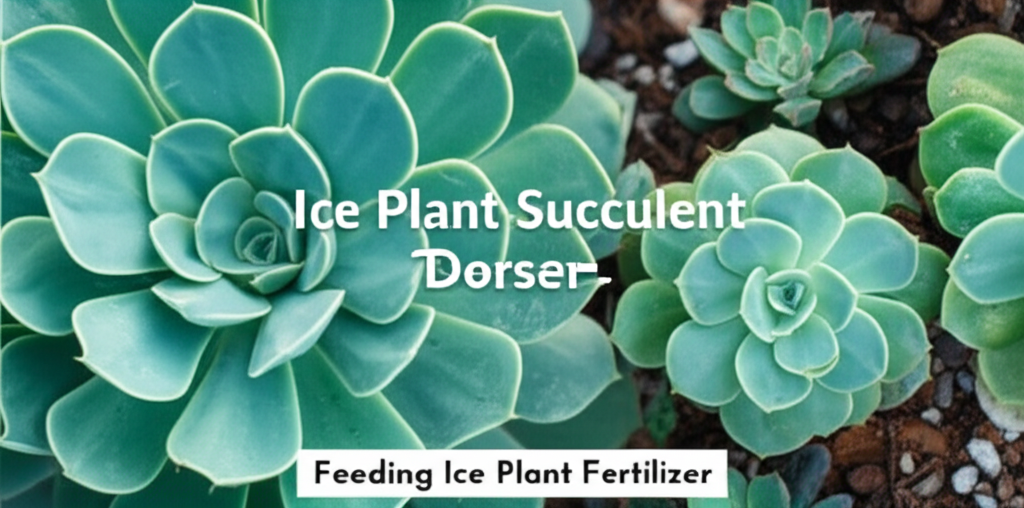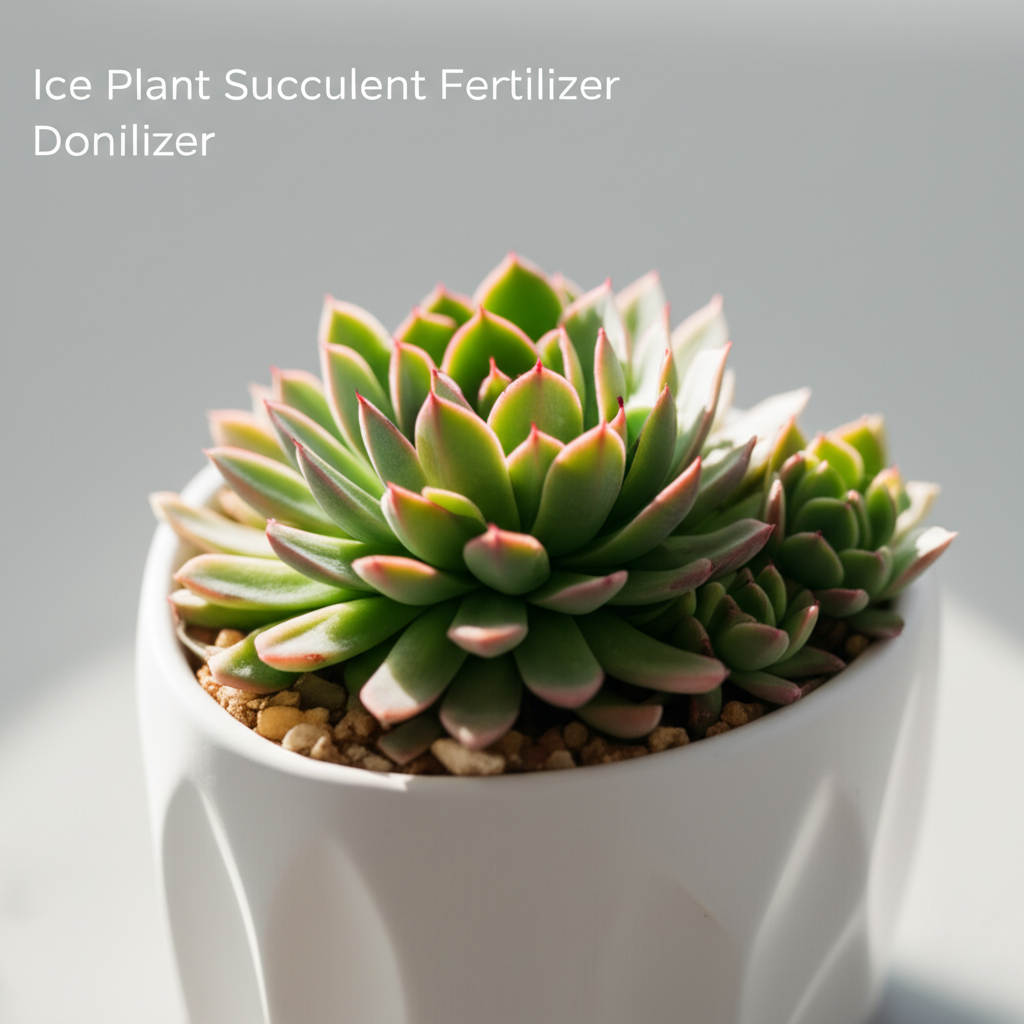Introduction: The Dazzling Appeal of Ice Plants and the Importance of Fertilization
Ice plants, belonging to the family Aizoaceae, are a spectacular group of succulents celebrated for their vibrant, jewel-like flowers and fleshy, often crystalline leaves. Their ability to thrive in arid conditions and their sprawling, groundcover habit make them a popular choice for rock gardens, borders, and slopes. While generally low-maintenance, providing the right nutrients through proper fertilization can significantly enhance their vigor, bloom production, and overall health. However, over-fertilizing or using the wrong type of fertilizer can be detrimental, leading to weak growth, leaf burn, and a reduced ability to withstand environmental stresses. This comprehensive guide will navigate you through the essential dos and don’ts of fertilizing ice plant succulents, ensuring your garden specimens reach their full, dazzling potential.
Understanding Ice Plant Nutritional Needs

As succulents native to arid and semi-arid regions, ice plants have evolved to thrive in nutrient-poor soils. This means their nutritional requirements are quite different from many other garden plants. They don’t need heavy feeding; in fact, excessive nutrients can be harmful. Their primary needs revolve around a balanced supply of macronutrients (Nitrogen, Phosphorus, Potassium) and micronutrients, but in moderation.
Nitrogen (N): For Leaf and Stem Growth
Nitrogen is crucial for vegetative growth, promoting lush foliage and healthy stems. However, for succulents like ice plants, too much nitrogen can lead to soft, watery growth that is more susceptible to pests, diseases, and frost damage. It can also inhibit flowering.
Phosphorus (P): For Root Development and Flowering
Phosphorus is essential for strong root development and plays a vital role in the blooming process. A good phosphorus supply encourages abundant and vibrant flowers, which is a primary reason many gardeners choose ice plants.
Potassium (K): For Overall Plant Health and Stress Tolerance
Potassium contributes to overall plant vigor, disease resistance, and tolerance to environmental stresses such as drought and cold. It helps regulate water within the plant and strengthens cell walls.
Micronutrients: The Supporting Cast
While required in smaller quantities, micronutrients like iron, manganese, zinc, and boron are critical for various metabolic processes, including photosynthesis and enzyme activation. A balanced fertilizer will typically contain these in small amounts.
When to Fertilize Ice Plant Succulents
The timing of fertilization is as important as the type of fertilizer used. Ice plants are primarily active growers during their warmer seasons, typically spring and summer.
The Growing Season: Spring and Early Summer
The optimal time to fertilize ice plants is during their active growing period, which usually begins in spring as temperatures rise and continues into early summer. This is when they have the energy to utilize the nutrients effectively.
Avoid Fertilizing During Dormancy or Stress
It’s crucial to avoid fertilizing when the plant is dormant, typically during winter, or when it is experiencing stress from extreme heat, drought, or recent transplanting. Fertilizing stressed plants can exacerbate their problems.
Ice Plant Fertilizer: The Dos
Adhering to these best practices will ensure your ice plants receive the nourishment they need without succumbing to over-fertilization.
Do Use a Balanced, Low-Nitrogen Fertilizer
The golden rule for fertilizing ice plants is to opt for a balanced fertilizer with a low nitrogen content. Look for fertilizers with an NPK ratio like 10-10-10 or even lower in nitrogen, such as 5-10-10 or 5-5-5. This provides essential nutrients without promoting excessive, weak foliage.
Do Dilute Fertilizers Significantly
Succulents are sensitive to fertilizer burn. It is always advisable to dilute liquid fertilizers to half or even quarter strength recommended on the packaging. For granular fertilizers, apply sparingly.
Do Fertilize Sparingly
Ice plants are adapted to low-nutrient environments and do not require frequent feeding. Fertilizing once or twice during the entire growing season is usually sufficient. Over-fertilizing is a common mistake that can lead to more harm than good.
Do Consider Organic Fertilizers
Organic fertilizers, such as compost or well-rotted manure, release nutrients slowly and improve soil structure. A light top-dressing of compost around the base of the plants in early spring can provide a gentle, sustained nutrient supply.
Do Fertilize After Watering
Always water your ice plants thoroughly before applying any fertilizer. Applying fertilizer to dry soil can increase the risk of root burn. Watering beforehand ensures the roots are hydrated and can absorb nutrients more evenly.
Do Observe Your Plants
Pay close attention to the visual cues your ice plants provide. If they appear healthy, with good color and regular blooming, they likely don’t need additional fertilization. Signs of deficiency, such as pale leaves or significantly reduced flowering (after accounting for seasonal variations), might indicate a need for a very light feeding.
Ice Plant Fertilizer: The Don’ts
Avoiding these common pitfalls will protect your ice plants from nutrient-related damage.
Don’t Over-Fertilize
This is perhaps the most critical “don’t.” Excessive fertilization can lead to salt buildup in the soil, burning the roots and damaging the foliage. It can also cause leggy, weak growth and inhibit blooming.
Don’t Use High-Nitrogen Fertilizers
Fertilizers high in nitrogen (e.g., 20-20-20) will encourage rapid, soft growth that is unattractive and unhealthy for succulents. This type of growth is also more prone to pests and diseases.
Don’t Fertilize Dry Soil
As mentioned in the “dos,” fertilizing dry soil can concentrate the salts in the fertilizer, leading to root burn. Always ensure the soil is moist before fertilizing.
Don’t Fertilize During Extreme Weather Conditions
Avoid fertilizing during periods of extreme heat, drought, or when the plants are already stressed. The plant’s ability to absorb and process nutrients is compromised under such conditions.
Don’t Apply Fertilizer Directly to the Leaves or Stems
Granular fertilizers should be applied around the base of the plant, away from direct contact with the foliage and stems. If using liquid fertilizer, ensure it is diluted and applied to the soil.
Don’t Fertilize Newly Planted or Repotted Ice Plants
Newly planted or repotted succulents need time to establish their root systems. Fertilizing too soon can shock the plant and hinder its recovery. Wait at least 4-6 weeks after planting or repotting before considering a very light feeding.
Key Facts and Comparison of Fertilizer Types
Here’s a handy comparison of common fertilizer types and their suitability for ice plant succulents.
| Fertilizer Type | NPK Ratio (Typical) | Release Rate | Suitability for Ice Plants | Pros | Cons |
|---|---|---|---|---|---|
| Balanced Synthetic | 10-10-10, 20-20-20 | Fast | Moderate (requires dilution and sparingly) | Readily available nutrients, precise ratios | High risk of burn, can leach nutrients, no soil improvement |
| Low-Nitrogen Synthetic | 5-10-10, 5-5-5 | Fast | Recommended | Lower risk of burn, promotes flowering, balanced nutrients | Still requires dilution and careful application |
| Organic Compost | Variable (typically low NPK) | Slow | Highly Recommended | Improves soil structure, provides micronutrients, slow nutrient release, low risk of burn | Nutrient ratios are less precise, may attract some pests if not fully composted |
| Liquid Fertilizers (General Purpose) | Variable | Fast | Moderate (requires significant dilution) | Quick uptake of nutrients | High risk of burn, needs frequent application, can leach |
| Slow-Release Granular Fertilizers | Variable | Slow (over months) | Moderate (use cautiously) | Convenient, reduces frequency of application | Can still cause burn if applied too heavily, less control over nutrient release |
Step-by-Step Guide to Fertilizing Ice Plants
Follow these steps to ensure you fertilize your ice plants correctly and safely.
Step 1: Assess the Need
Observe your plants. Are they showing signs of deficiency (pale leaves, poor growth, lack of flowers) or do they look robust and healthy? If they look healthy, skipping fertilization is often the best approach.
Step 2: Choose the Right Fertilizer
Select a low-nitrogen, balanced fertilizer (e.g., 5-10-10, 5-5-5) or high-quality organic compost.
Step 3: Water Thoroughly
Before applying any fertilizer, water your ice plants well. Allow the water to soak into the soil for at least an hour, or water the day before.
Step 4: Dilute Liquid Fertilizers (if used)
If you are using a liquid fertilizer, dilute it to half or quarter strength of the manufacturer’s recommendation.
Step 5: Apply Fertilizer
- For Liquid Fertilizer: Pour the diluted solution around the base of the plant, avoiding contact with the foliage and stems.
- For Granular Fertilizer: Apply a small amount around the base of the plant, ensuring it doesn’t touch the stems. Gently work it into the top inch of soil or simply leave it on the surface as it will be watered in.
- For Organic Compost: Apply a thin layer (about 1-2 inches) of compost around the base of the plant, keeping it a few inches away from the main stem.
Step 6: Water Again (Optional but Recommended)
After applying granular fertilizer, a light watering can help it dissolve and move into the soil.
Step 7: Monitor
Observe your plants for any signs of stress or improvement over the next few weeks.
Pros and Cons of Fertilizing Ice Plants
While fertilization can be beneficial, it’s essential to weigh the potential advantages against the risks.
| Pros | Cons |
|---|---|
| Enhanced Flowering: Can lead to more abundant and vibrant blooms. | Risk of Root Burn: Over-fertilization or improper application can damage roots. |
| Improved Vigor: May promote healthier foliage and more robust growth. | Weak, Leggy Growth: High nitrogen can cause unsightly, weak stems. |
| Increased Stress Tolerance: Properly nourished plants may better withstand drought and cold. | Inhibition of Flowering: Ironically, too much nitrogen can reduce bloom production. |
| Faster Recovery from Stress: A well-fed plant might bounce back quicker from adverse conditions. | Salt Buildup: Can occur in soil from excessive fertilizer, harming roots. |
| Improved Overall Appearance: Healthier plants are more visually appealing. | Environmental Concerns: Synthetic fertilizers can contribute to water pollution if leached. |
Alternative Nourishment: The Power of Good Soil
For many ice plant varieties, the most crucial “fertilizer” is simply a well-draining soil mix. Native to sandy or rocky soils, ice plants detest waterlogged conditions. Providing a gritty, well-aerated potting mix or amending garden soil with gravel, perlite, or coarse sand is far more important than a feeding schedule. A good soil foundation ensures proper aeration, drainage, and prevents root rot, which is a common killer of succulents.
When planting, consider amending the native soil with compost and grit. The compost provides a slow release of trace nutrients and improves soil structure, while the grit ensures excellent drainage. This combination often provides sufficient sustenance for ice plants, negating the need for regular synthetic fertilization.
Conclusion: A Balanced Approach to Thriving Ice Plants
Fertilizing ice plant succulents is a delicate balancing act. By understanding their natural origins and adapting your approach to their specific needs, you can ensure they flourish. Prioritize excellent drainage, lean soil, and infrequent, diluted feeding with a low-nitrogen fertilizer or organic compost. Observe your plants closely, and remember that in the world of succulents, less is often more when it comes to nutrients. With careful attention to these dos and don’ts, your ice plants will reward you with a spectacular display of color and vitality for seasons to come.


